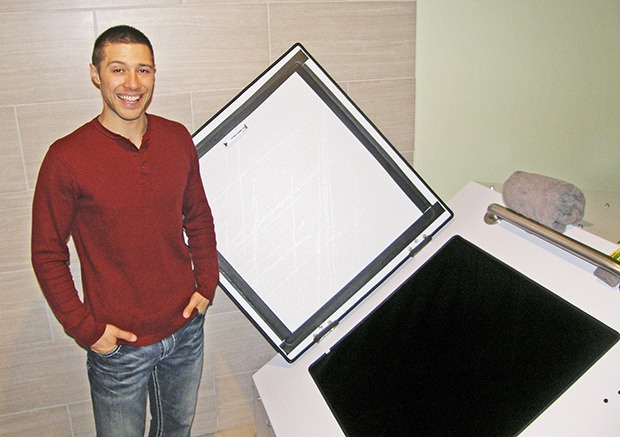Corklike, in a closed 4-by-8 foot sensory deprivation tank, I bob.
As weightless as I would be on the Dead Sea, in water suffused with 1,000 pounds of Epsom-salt, heated to the surface temperature of the skin.
Hearing nothing but my own heart, seeing nothing, catching only the faint bite of salt in the nose, man and mind are left alone to contend with each other.
At first it is not a comfortable thing. Twenty minutes in, the mind, accustomed to its daily gobsmacking of sensory input, starts to nicker and paw.
“Look here, body,” says mind, “you’ve had your fun, but don’t you have something else to do?”
For this first encounter, I can manage only 30 of the 60 minutes that constitute a regular session.
But I expect to stay in longer next time.
Phillip McGraw, who opened U-Float at 124 E. Main St. next to the Banana Museum and the Rainbow Cafe a month ago, said that becoming aware of the constant background noise we don’t know occupies our mind every day and presenting a place to still it is one of the best things the tank can do for a person.
McGraw said the benefits to mind and body are many and profound.
“Given the buoyancy of the body, it counters about 85 percent of gravity,” McGraw said. “This allows your spine to decompress up to about one inch, so it takes gravity’s effects off of your discs and your joints. And since there’s so much Epsom salt in there — 20 bags per tank — it’s a natural [anti-inflammatory] for sore muscles and inflamed joints. It drives toxins out of the body, like the lactic acids you have after a hard workout. And the body heals four times faster than with mere bed rest.
“Along with that you have reduced cortisone levels and the brain produces endorphins and dopamines, which are our natural anti-depressants,” McGraw added.
Jonathan Lilly, a former physicist at The National Institute of Health, wondered in what would happen if one were to shut off all sensory input to the brain, so in 1954 he invented the sensory deprivation tank. Most of his colleagues believed that a person inside such a tank would drop off to sleep right away.
Lilly worked up some crude versions of the deprivation tank, but it wasn’t until the 1970s that he started working with the people who owned a company called Samadhi. It would become the pioneer of the commercial use of the invention.
McGraw understands that despite the sensory deprivation tank’s nearly 60 years in existence, many people still dismiss it as “mere hippy, New Age,” mumbo-jumbo.
“After my first float, I gotta admit I kind of felt that too,” McGraw said. “Like, ‘now that was weird, but how can anything benefit you if you just lie there, doing nothing?’ But what it’s triggered in me since I have done it more is help me realize the power of slowing down in life. And what that does is unbelievable.”
A typical session, which lasts 60 minutes, costs $65.
When a new customer comes in, McGraw said, the first thing he does is get a bead on the person’s concerns. That done, he takes the customer to the float rooms to let him or her have a look at the equipment.
“Many people fear they are going to be claustrophobic, which a lot of times is a control issue,” McGraw said. “I show them that the door to the tank is not latched — it just lies on the tank and flaps open. If you are uncomfortable, you can float with the door open.”
Before and after each session, customers must shower. No disease-carrying organisms, however, can survive in such a concentration of salt water.
One can even sleep in the tank.
“I’ve gotten some of the best sleep in my life in the tank. In bed, we toss and turn because our circulation is pinched. There are no pressure points in the tanks, so that allows for increased blood flow as well. It lowers your heart rate and your blood pressure. And it’s all verified by biofeedback and electroencephalograms,” McGraw said.
Given all that, why hasn’t it caught on?
“The reason this hasn’t shot into the public perception like it’s doing now is that we’ve never needed it as much as a society as we do now, with cell phones, email text messages, advertisements and all the sensory bombardment that hits us every day,” McGraw said.
For more information, call 206-427-0609. The email address is www.ufloat.org.


